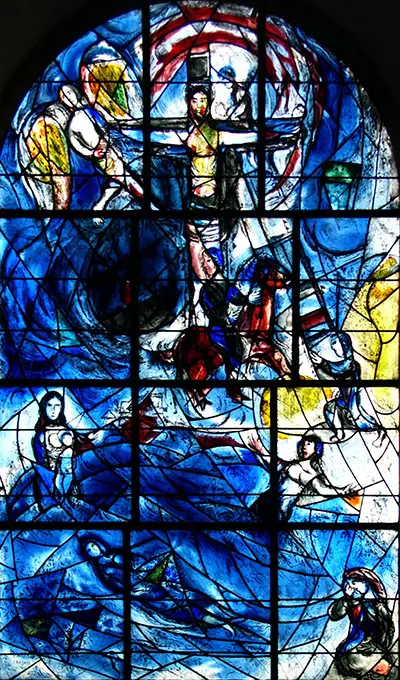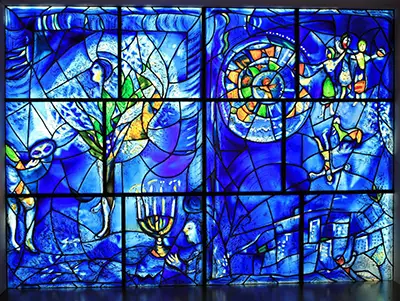Nature could be used to bring his work to light and he found the early results of his foray into this medium to be exciting and breathtaking. Chagall was also a religious and spiritual man who found the opportunity to incorporate his art into places of worship as something too good to refuse. Although Jewish, he actually felt a connection to faith as an overall topic and would produce stained glass windows for venues of other faiths too. The calming nature of these locations, combined with his own art, should help others to connect with their spiritual natures, or so he hoped.
The artistic style used by Chagall in his paintings was entirely suitable for this alternative medium. Bright colour was very much his trademark, with a generally small number of figures included in his scenes. Chagall would need to learn the techniques of stained glass window production in order to get the best result possible, whilst some other artists would purely be involved in the design work, before handing over to a colleague for the technical side. It would have been hard for Chagall to allow another to take on his own designs and so he became involved in the whole process. He also used techniques that had never been seen before in a continuation of his genius-like innovation and creativity.
Chagall himself was influenced by, and contributed to, many art movements which most notably included Fauvism, Symbolism and Cubism. He also drew in further ideas from his upbringing in the USSR as well as the Jewish community of which he was a prominent and proud member. Prior to working with stained glass he had also travelled around major art destinations in Western Europe that furthered his knowledge and understanding of different artistic styles and eras. The artist has spent considerable amounts of time living in areas with bright sunshine which would have made it easier to get to work on these new projects, though not all of them were installed in regions that were typically draped in sunshine.
Many different art moments have been mentioned in the same breath as Chagall’s career, mainly because his style was unique, entirely his own, but it did overlap a number of different styles which together produced one of the finest contributions to the modern art movement. Expressionism, Surrealism and Naive art have also been linked to him, as well as the others mentioned in the previous paragraph. Who might he have studied, specifically related to the art form of stained glass windows? The most famous contributors of recent times would have been the likes of William Morris, Edward Burne-Jones, Charles Rennie MacKintosh and Alphonse Mucha. This is a technique which has been used for many centuries, dating back way before the Renaissance, for example. Examples can be found in medieval Europe and also in other cultures such as across the Middle East. The Egyptians and Romans were known to have produced large amounts of artistic glass but in recent centuries it has been France and the UK who have been behind a revival in this popular art form.
One should not be surprised that Chagall entered into stained glass design, for he was an open minded, ambitious artist. Best known for painting and illustration, he was also involved in ceramics, stage sets and tapestries. In that sense, he bore similarities with the British Pre-Raphaelites who embraced a whole host of different avenues of artistic expression and built several businesses that could cater to a wide variety of tastes and requirements. In those companies, artists would often end up finding their specialist niche but Marc Chagall wanted to be involved in every stage of development of any possible artistic medium. Chagall’s stained glass windows did not appear until he was in his seventies, marking this period of work out as being inspired and supported by all that had come before.
Marc Chagall's first stained glass window was completed in 1956 for a French church. He used Charles Marq at the Jacques Simon Workshop for consultation and technical advice and this partnership continued through his work in this medium. This was an artist who strives to achieve the highest quality of output and was not too arrogant to realise that when entering new art forms that knowledge was needed from others. He was a passionate artist who learnt quickly and picked up his tutor’s technical advice like a sponge. Those spreading their time between a multitude of mediums would have to call on advice from respected and experienced individuals as there would never be the time to organically develop your own knowledge in each. Further information would be gleaned from publications on other notable designers related to stained glass windows, many of whom were mentioned in the previous paragraph.
He would then complete three pieces for the Metz cathedral which spanned a decade due to his commitments elsewhere. There were also a number of commissions in the UK where a passion for this art form combined with a number of wealthy religious organisations made this an ideal market for his highly respected services. There was a single window at Chichester Cathedral in England before a highly significant series at the All Saints’ church in Tudeley, Kent. This was a cross-religious piece for a couple of Jewish and Christian background. Chagall was not uncomfortable by this combination at all, in fact he saw a possibility for the union of monolithic religions to find a common ground and seek a collective spiritual movement.

